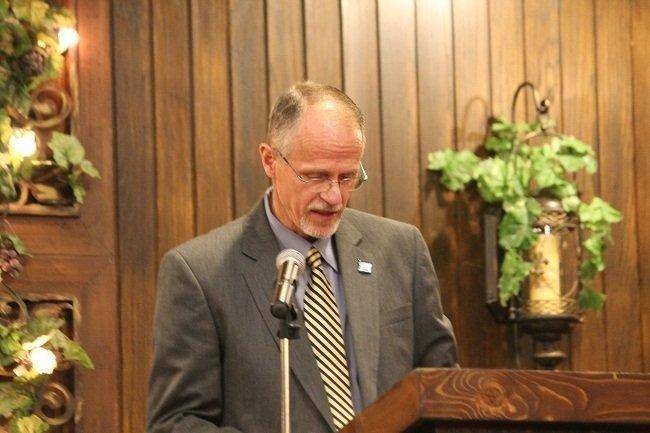USU Eastern Chancellor Joe Peterson and USU President Stan Albrecht hosted an informational luncheon for community leaders of Carbon and Emery Counties this past Wednesday.
The luncheon also celebrated both the official name change to USU Eastern and the 75 years it has been in operation.
Peterson began his remarks by announcing an upcoming birthday party. Next fall is the college’s 75th anniversary.
“There will be a celebration appropriate for such a venerable and beloved institution,” he said. “I told folks to prepare to celebrate.”
He went on to remind the crowd that the informal name used to refer to the college for the past three years, USU Eastern, became the college’s official name last month with the help of Senator Davis Hinkins and Representative Jerry Anderson.
Governor Gary Herbert’s Deputy of Community Relations Mike Mower presented a signed ceremonial copy of the legislation.
Peterson spoke about the construction project on 300 E., just south of the Jennifer Leavitt Student Center. The fomer art building will be remodeled to house the college’s new center for workforce development.
The center’s goal is to build a partnership between the college and the Utah Department of Workforce Services and other workforce and economic development agencies.
“It’s our hope that education in CTE and workforce areas becomes more prominent to our students, and that the college is more prominent to local employers as the best source for skilled workers,” Peterson said in an email.
Those in attendance learned more about the college and the university’s demonstration plant that will bring clean metallurgical coke technology, jobs and training opportunities to the region. There was a short film documenting the college’s new Carbon Energy Innovation Center (CEIC) located at the previous WETC facility. Private companies are building a plant that they hope will revolutionize the production of coke, an essential ingredient in steel. The plant construction is nearly complete and soon will begin industrial-scale production, using a process that significantly reduces the environmental impacts of traditional production methods. The process will extend and expand the value of the regional mineral resources.
Peterson spoke of the progress of the Four in Four Campaign.
“We at the college have understood that growing our enrollment is a key service that we absolutely must provide to southeast Utah. In addition to educating our local residents, our children and neighbors, we must attract people from outside of our region into our communities. We must give those coming here a high-quality educational experience that forms attachment to our region.
“By bringing outsiders into our region, we create two important outcomes. First, we convert some of those outsiders into life-long southeast Utahans. They become our neighbors and they contribute to our economy and region. Second, we send some of those outsiders back to their home communities around the world where they become committed ambassadors for southeast Utah.”
Albrecht said that USU came to know of the Eastern’s need for more adequate facilities. The university committed itself to making these facilities a top priority. He remarked about significant recent progress related to the new central instruction building, a large multi-purpose structure that will remodel and expand the Geary Theatre and replace the dangerous and dilapidated SAC and music buildings.
He announced in addition to the $500,000 legislative allocation Eastern received, Marc Bingham and Tony Basso have given the college a $250,000 donation. The college now has $1,000,000 with which to move forward.
Albrecht explained that before the legislative cycle next year, the college will raise additional funding needed to hire architects and complete the programming and planning phase of the building for a “shovel-ready” building project.
Peterson concluded the luncheon with the following remarks:
“The logic is simple: our region needs greater economic and educational vitality. In concert with the university, the college can help increase these opportunities. However, the college’s success requires adequate and functional facilities. The legislature has reached out to the region with a supportive allocation, and now the college can build on this success with help from community partners.”

